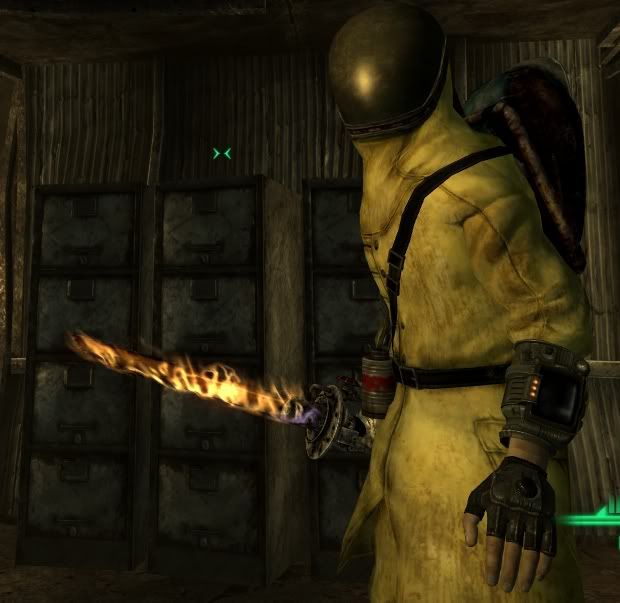Continuing on from my last post, these are my thoughts on Bethesda's action-rpg, Fallout 3. Sorry that it's a bit late, but I got caught up in some other stuff.
Now, if this were simply a first-person shooter, talking about the core combat would've been the end of gameplay discussions. But, considering that there are a heavy amount of RPG elements at play, I'll have to offer my opinions on them as well.
First off, I thought the inventory system was simplistic, but pretty good. Things were pretty well organized, and it's neat to be able to bring up your inventory in-battle and use items. Sorta reminds me of the item-swapping done in The Legend of Zelda, actually. That being said, at times the inventory can get really cluttered, and it would've been nice to have some sort of filter to organize by weapon damage or armor defense, instead of just by name. Still, it works quite well.
Actually, that does bring up the matter of the Pip-Boy, which is your method of information storage and organization.
Sort of like a tri-corder from Star Trek, it scans health and allows VATS to operate. To be honest, I think the idea is pretty cool. It also collects notes and picks up radio stations, as well as create and log maps. It's nice because it keeps everything in one place, and you can easily swap between looking at your stats like health, checking your inventory, and looking at the information you've gathered. All while the game is conveniantly paused. Note that there is a brief period of inaction before and after the Pip-Boy is brought up, during which things still move and the enemy can damage you. This is a pretty fair element though, considering that you're allowed to basically stop time as you change armor.
And speaking of armor, the damage in the game is pretty interesting as well. The game has a concept of area-specific damage, such that if you get shot enough in the head (or you shoot the enemy enough in the head) their perception drops and it's easier to surprise them. There's also enemy weakpoints in the game, that if precisely hit and damaged can make enemies go crazy or slow them down, or do a lot more damage. Shooting an escaping target's legs can slow their speed and allow you to catch up. It's a nice feature that adds more depth to what would be otherwise bland battles.
The variety of items in the game isn't huge, but it is quite decent. You have a lot of different weapons with different damage, spread, reload times, and such; armors with different bonuses such as damage reduction or stat bonuses (to charisma or the like); and edibles which act as your standard RPG potions.
The armor and weapons also have weapon degradation, which often has the problem of being annoying. I found though that this annoyance was offset by the fact that it both makes sense, and that enemies' weapons are often degraded as well. This means that if you take out a bunch of Talon Mercenaries, and you have a high enough repair skill, you can take all their armor and repair it together to create something you can wear that is stronger than any of the pieces seperately. It's a neat idea and adds another interesting dimension to the game.
The game also allows you to build certain weapons from blueprints using items scattered about the wastelands, and it's really satisfying to scavenge together a flaming sword from a lawnmower and a motorcycle, then go kill Supermutants with it. Only downside is that you can't create blueprints yourself, and there's not that many of them.
Now one thing I haven't mentioned yet is radiation. Quite simply, the game takes place in a nuclear wasteland, so there's a lot of irradiated stuff. Simply eating food or drinking water is going to make you more irradiated, and this too adds another element to the game. Fortunately for your character, there are lots of RadAway packs lying around, and the radiation effects come slowly and aren't too dangerous. Unfortunately for the player, this means that you'll probably ignore the radiation effects most of the time, or at least won't find it much of a threat. Until you hit 600 rads at which point you give up and die.
So to summarize: Great inventory usage and item selection, although there aren't tons of different weapons. Weapon creation is satisfying, and degradation adds a fun element to the game. Area-specific-damage is a nice addition to the battles, giving them more flavour, but the effects of radiation are almost negligible.
Images used in this review do not belong to me, nor do their contents. I took none of them myself, but merely found them on Google. I assume no ownership and am using them for referential purposes. If you do not wish them to be used, simply send me an e-mail and I will replace them.




No comments:
Post a Comment